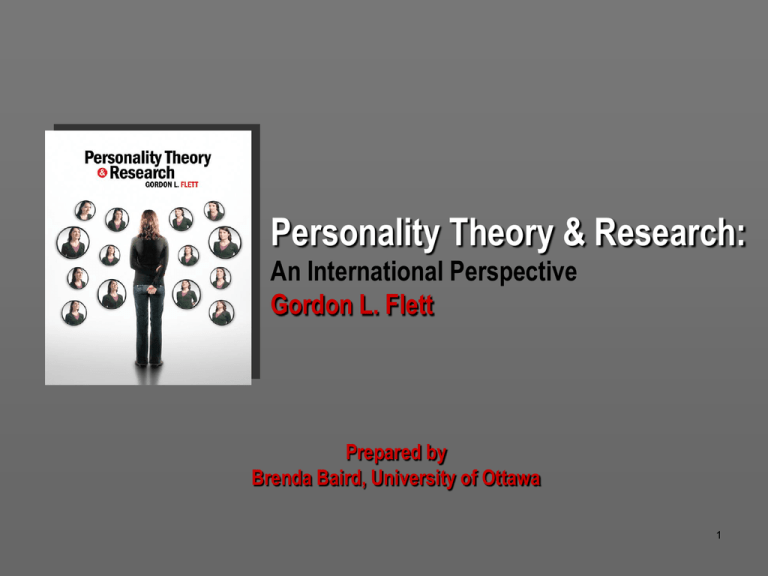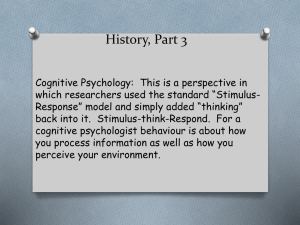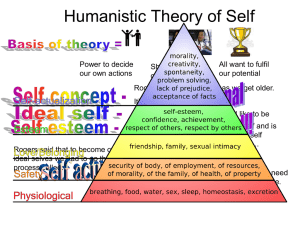
Personality Theory & Research:
An International Perspective
Gordon L. Flett
Prepared by
Brenda Baird, University of Ottawa
1
Chapter 7 Overview
•
•
•
•
•
Common Theories of the Humanists
Maslow’s Humanistic Theory
Carl Rogers
The Assessment and Measurement of
Self-Actualization
The Contemporary Focus on Well-Being
2
Common Themes of the Humanists
• Humanistic theories are also called
organistic theories with a focus on the entire
person
• A central theme in humanistic theories is the
drive toward self-actualization, to realize
one’s full potential
• Other themes include personal growth,
openness to experience, living in the
present, personal responsibility, and the
inherent goodness of people
3
Common Themes of the Humanists
• For the humanists, the unit of analysis is
perceived reality
• In contrast to Freudian determinism,
humanists emphasize personal
responsibility and choice
• The humanists’ view that persons are
inherently good with unique attributes for
greatness has led to a movement called
positive psychology
4
Maslow’s Humanistic Theory
Deficiency Motives and Growth Motives
• Maslow believed that neurosis was due to a
lack of personal growth, and neurotic needs
indicated a loss of capability (deficiency)
• For Maslow, conflict was a reflection of
mental health and indicated a desire for
personal growth
5
Maslow’s Humanistic Theory
The General Characteristics of Needs
• Maslow is noted for his hierarchy of needs that
arranges five needs in order of relevance to
physical and psychological survival
• Lower needs (physical) are stronger and more
tangible than higher needs (psychological)
• Needs must be satisfied in hierarchical order
with lower needs satisfied before higher needs
(e.g., food, safety, love, esteem, and selfactualization)
6
Maslow’s Humanistic Theory
The Hierarchy of Needs
• Lower needs reflect a deficiency state
whereas higher reflect personal growth and
occur later in development
•
1.
2.
3.
4.
5.
The five needs in hierarchical order include:
Physiological Needs (thirst, hunger, sex)
Safety Needs (physical and emotional)
Belonging and Love Needs (sustained intimacy)
Esteem Needs (personal competence)
Growth Needs (self-actualization- a process
7
Maslow’s Humanistic Theory
8
Maslow’s Humanistic Theory
The Hierarchy of Needs
• Maslow differentiated between a deficient,
selfish form of love that is focused on the self
(D-love) and an unselfish love that is focused
on another (B-love)
• B-love is associated with the process of selfactualization
• Persons who do not satisfy the need to belong
are at risk for emotional problems as outlined in
Durkheim’s (1963) theory of anomic suicide
9
Maslow’s Humanistic Theory
The Psychological Characteristics of Healthy
Self-Actualized People
• Critics note Maslow subjectively examined
qualities of famous people to determine the
characteristics involved in self-actualization
• Maslow referred to peak experiences as
wondrous moments that transcend time, space,
and self
• Maslow believed self-actualization results when
desacralizing ceases (an immature defence
that ignores the sacred value of needs)
10
Maslow’s Humanistic Theory
11
Maslow’s Humanistic Theory
The B-Values
• Maslow outlined 15 meta-motivations (Bvalues)
that must be satisfied for self-actualization
• An unsatisfied B-value is associated with a
specific pathological outcome
• Unlike Maslow’s needs, B-values are
equivalent and have no hierarchical
relevance
12
Maslow’s Humanistic Theory
13
Maslow’s Humanistic Theory
Associated Research on the Nature of SelfActualization
• Researchers suggest that people who selfactualize are low in anxiety and high in selfacceptance
• Flett et al. (1991) showed that, ironically,
striving for perfection is related to low levels
of self-actualization
• Kasser and Ryan (1993,1996) showed a
negative relation between self-actualization
and the pursuit of extrinsic goals
14
Maslow’s Humanistic Theory
Maslow’s Views on Personality
• Masow believed a fully functioning person is
an integration of several personality
syndromes
• Personality syndromes are behaviours that
are determined by specific social and
cultural situations
• Maslow emphasized the spiritual, not
material, aspects of environment in
personality development
15
Maslow’s Humanistic Theory
Evaluation of Maslow’s Theory
• Statistical techniques such as the Guttman
scale analysis confirm the empirical nature
of Maslow’s hierarchy of needs
• Critics have raised concerns over the exact
order of stages, a role for altruism, and the
abstract nature of self-actualization
• Self-actualization may be better conceived
as a unique process rather than as a
generalized end state
16
Maslow’s Humanistic Theory
Maslow’s Views on Culture
• For Maslow, self-actualized persons transcend
cultural values
• Maslow supported Benedict’s (1970) notion of
synergy as reflected in cultural differences that
emphasis wealth (low synergy) or well-being
(high synergy)
• While critics note Maslow’s failure to address
gender differences in needs, Hyde (2005)
suggested that genders are equivalent and
found support for her gender similarities
hypothesis
17
Carl Rogers
The Organism, the Self, and Personality
Structure
• Rogers viewed personality as an organism
shaped by experiences that form a
phenomenal field of perception
• For Rogers, the goal of therapy is to restore
a trust in our own perception of reality as
opposed to another’s reality
18
Carl Rogers
•
Rogers described two needs as essential
to well-being:
1. The need for self-regard: an unconditional
positive view of the self
2. The need for self-actualization: a need to
reach one’s full potential
19
Carl Rogers
The Need for Self-Regard
• Rogers described conditions of worth as
instances in which one’s personal desires are
disregarded in favour of those deemed
desirable by another
• Conditions of worth restrict autonomy, threaten
self-regard, and distort the true self
• The gap between the true and the ideal self is
assessed by Rogers’ Q-sort technique
• The solution to conditions of worth is an
unconditional positive regard from significant
others who offer love without conditional terms
20
Carl Rogers
The Need for Self-Actualization
• A key aspect of self-actualization is the
actualizing tendency that is determined by an
internal organismic valuing process
• This process reflects our innate tendency
toward self-enhancement and is described
as:
1. Organismic (innate)
2. Active (self-directed)
3. Directional (growth-oriented)
4. Selective (chooses some capabilities)
21
Carl Rogers
The Fully Functioning Person
• Rogers maintained that to be fully functioning,
one must:
–
–
–
–
be open to experience
live in the moment
live life to the fullest
trust own intuition
• For Rogers, defence mechanisms are
employed to combat anxiety during the
process of subception—an unconscious
awareness that feedback is not congruent with
the self-perception
22
Carl Rogers
Contemporary Research Reflecting Rogers’
Theory
• Rogers’ notion of a discrepancy between
the actual and ideal self has led to research
such as Flett, Hewitt, Blankstein, and
Gray’s (1998) Perfectionism Cognitions
Inventory (PCI)
• Elevated scores on the PCI are associated
with perfectionism and anxiety
• Rogers believed the root of anxiety is in
conditions of worth
23
Carl Rogers
Self-Worth Contingencies
• Conditions of worth exist across life domains
• Crocker, Luhtanen, Cooper, and Bouvrett
(2003) identified six factors related to selfworth contingencies
• Assor, Roth, and Deci (2004) suggested an
intergenerational transmission of conditions
of worth
24
Carl Rogers
25
Carl Rogers
Personality Change and Client-Centred
Therapy
• The Rogerian approach to therapy is clientcentred through a process of self-discovery
• The role of therapist is to create a condition
of trust and empathy
• Rogers (1961) outlined key challenges and
consequences of successful treatment
26
Carl Rogers
27
Carl Rogers
Evaluating the Contributions of Client Centred
Therapy
• Rogers is regarded as the founder of
psychotherapy research
• Research has identified a therapeutic
advantage of the Rogerian focus on
empathy in treating borderline personality
and sex offenders
• Rogers contributions extend to educational
settings
28
Carl Rogers
The Evaluation of Rogers’ Theory
• Critics see Rogers’s positive stance as a
naïve view of all humans
• Rogers techniques may not generalize
across cultures, or to persons
unaccustomed to verbal self-expression
• Rogers’ universal need for self-regard has
been challenged due to cultural variants on
self-criticism and self-enhancement
29
The Assessment and Measurement
of Self-Actualization
•
•
•
Shostrom’s (1964) Personal Orientation
Inventory (POI) and Shostrom’s (1975)
Personal Orientation Dimensions (POD)
tap dimensions of self-actualization
Criticisms concerning the length of the
POI and POD led to the development of
Jones and Crandalls’ (1986) Short Index
of Self-Actualization (SI)
The SI has been criticized for factorial
validity
30
The Assessment and Measurement
of Self-Actualization
31
The Contemporary Focus on WellBeing
•
•
1.
2.
3.
4.
5.
6.
Current research reflects Maslow’s influence,
and indicates a growing emphasis on
interpersonal and social conditions
Ryff (1989) identified six components of wellbeing:
Autonomy
Mastery
Personal growth
Positive relations with others
Purpose in life
Self-acceptance
32
Copyright
Copyright © 2008 John Wiley & Sons Canada, Ltd. All rights reserved.
Reproduction or translation of this work beyond that permitted by Access
Copyright (the Canadian copyright licensing agency) is unlawful.
Requests for further information should be addressed to the Permissions
Department, John Wiley & Sons Canada, Ltd. The purchaser may make
back-up copies for his or her own use only and not for distribution or
resale. The author and the publisher assume no responsibility for errors,
omissions, or damages caused by the use of these files or programs or
from the use of the information contained herein.
33






